Publications
Comparison of sample pretreatments used to distinguish between infectious and non-infectious foodborne viruses by RT-qPCR
- Date de publication : 2025-06-01
Référence
Lauzier AM, Douette É, Labrie A, Jubinville É, Goulet-Beaulieu V, Hamon F, Jean J. Comparison of sample pretreatments used to distinguish between infectious and non-infectious foodborne viruses by RT-qPCR. Journal of Virological Methods, 335:115130.
Information Complémentaire
To detect viruses such as hepatitis A virus (HAV) and human norovirus (HuNoV) in foods, RT-qPCR or other molecular methods are used, which cannot distinguish between infectious and non-infectious virions. Samples can be pretreated to limit detection to intact and presumably infectious virions. We compared propidium monoazide (PMA or PMAxx), platinum (IV) chloride (PtCl4), magnetic silica beads and centrifugal filter using HAV or HuNoV inactivated by heat, pulsed light, or sodium hypochlorite (NaOCl). PMAxx completely or nearly eliminated (3.96 ± 1.24 log gc) the RT-qPCR signal of HAV inactivated at 100°C for 10 min. Pretreatments could not reduce significantly RT-qPCR signal of HAV after pulsed light (0.74 ± 0.36 log gc) and NaOCl (0.24 ± 0.14 log gc) inactivation. Enzymatic treatments did not improve the results obtained with PMAxx. The exudate of raspberry, strawberry or oyster used as food matrices needed dilution by at least tenfold for PMAxx to to yield results comparable to virions without a food matrix. Overall, PMAxx shows good potential to discriminate between infectious and non-infectious despite some remaining limitations.
Mot(s) Clé(s)
Virus NoV HAV Détection Microbiologie alimentaire VIROCONTROL





